- News
- Reviews
- Bikes
- Accessories
- Accessories - misc
- Computer mounts
- Bags
- Bar ends
- Bike bags & cases
- Bottle cages
- Bottles
- Cameras
- Car racks
- Child seats
- Computers
- Glasses
- GPS units
- Helmets
- Lights - front
- Lights - rear
- Lights - sets
- Locks
- Mirrors
- Mudguards
- Racks
- Pumps & CO2 inflators
- Puncture kits
- Reflectives
- Smart watches
- Stands and racks
- Trailers
- Clothing
- Components
- Bar tape & grips
- Bottom brackets
- Brake & gear cables
- Brake & STI levers
- Brake pads & spares
- Brakes
- Cassettes & freewheels
- Chains
- Chainsets & chainrings
- Derailleurs - front
- Derailleurs - rear
- Forks
- Gear levers & shifters
- Groupsets
- Handlebars & extensions
- Headsets
- Hubs
- Inner tubes
- Pedals
- Quick releases & skewers
- Saddles
- Seatposts
- Stems
- Wheels
- Tyres
- Health, fitness and nutrition
- Tools and workshop
- Miscellaneous
- Cross country mountain bikes
- Tubeless valves
- Buyers Guides
- Features
- Forum
- Recommends
- Podcast
news
First ride: Fuji Transonic 1.3 aero road bike
You couldn't move for aero road bikes at this year’s Eurobike show in Germany, they're undoubtedly a popular category of road bike at the moment. I got the chance to ride the brand new Fuji Transonic, an aero road bike launched at the Tour de France (Dave covered the launch and you can read his story here) and raced by the Netapp-Endura team in that race.
Frame: Aero with direct mount brakes
First a recap on the new bike. The Transonic was two years in development and much of the engineering in the tube profiles and other design features stems from the work that developed the Norcom Straight time trial bike and Track Elite track bike. Well, once you've spent ages developing a time trial bike with the pure intention of going fast, you might as well share some of that engineering into your new road bike.
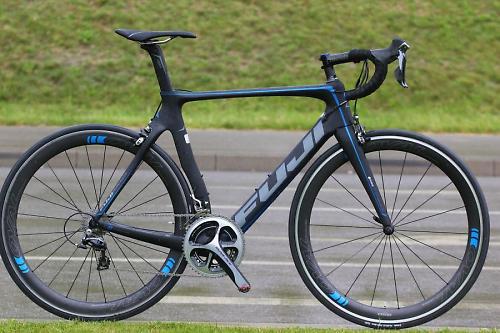
“We learned a lot on that project [both bikes were developed together] with many hours in the wind tunnel”, Fuji’s road product manager Steve Fairchild said. “The SST was our most-loved bike and our first aero road frame, but we needed to take the development to the next level.”
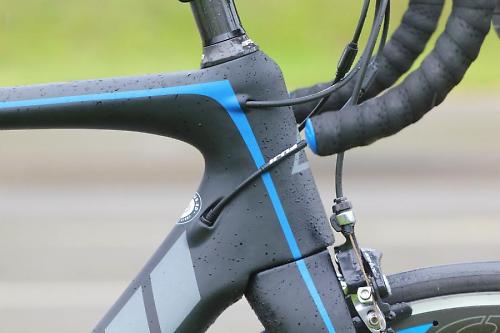
Make no mistake, the Transonic clearly has the presence of a bike designed for slicing through the aero cleanly, and saving you energy out on the road. The main tubes have been shaped from wind tunnel time, computational fluid dynamics and rider feedback. The down tube and seat tube has the requisite aero profile, and the seat tube also curves around the rear wheel.
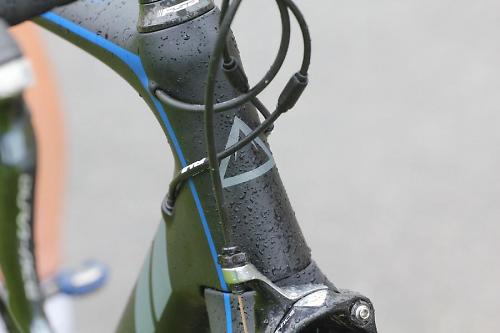
However, cheating the wind wasn't the only consideration, ride quality of was of the upmost important to Fuji too, so they chucked in a larger diameter 1 1/2in lower bearing into the tapered head tube to provide a decent amount of front-end stiffness. They could have reduced the frontal surface area with a smaller diameter headset bearing if they had wanted, but this is a race bike and it needs to offer the engaging and direct handling required of such a bike.
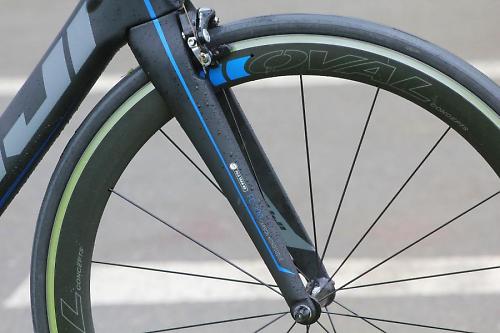
Other aerodynamic details include the seatpost, with the seat clamp embedded in the top tube. All cables are internally routed and the frame will take a mechanical or electronic groupset, and there’s a PressFit30 bottom bracket which allows the down tube and seat tube junction to be all oversized for extra stiffness.
Then there are the brakes, which as you can see are the new Shimano developed direct mount calipers - these use two bolts to mount directly to the frame. Most manufacturers are adopting them, such as Trek, Canyon, Colnago, but Fuji (like Canyon) have been sensible and placed the rear brake in the regular seatstay location, and not under the chainstays. The front brake is recessed a little into the new fork.
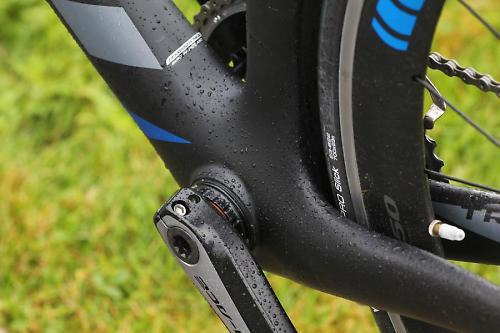
“We wanted to keep the rear brake on the chainstay so that in a race situation the mechanic can adjust it. We don’t want to be killing our mechanics!”, said Fairchild. “also if you pop a spoke it’s easy to just flip the quick release so you can keep going.”
The ride: Unitimidating speed and easy handling
Fuji’s Transonic, available exclusively through Evans Cycles, will be sold in seven different builds priced from £1,450 rising up to £4,800. The Transonic 1.3 I got to ride was decked out with Shimano Dura-Ace 11-speed mechanical groupset with Oval 950F carbon/alloy clincher wheels and Vittoria Rubino Pro 23mm tyres, with an Oval Concepts handlebar stem and saddle. This build costs £3,400, towards the higher end of the range.
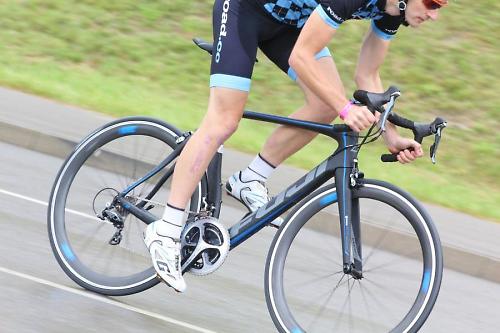
Riding the Transonic revealed it to be thoroughly capable, whether just cruising along or blatting along at full speed. It's got plenty of pace and acceleration that is for sure; kick hard on the pedals out of a slow corner and there is plenty of urgency in its reaction. It didn't respond with the same urgency as the new Canyon Aeroad CF SLX I was able to ride alongside the Transonic, but this was admittedly a very short ride so I don't want to draw any conclusive comparisons without indepth testing.
It's clearly a stiff frame, with a smooth and steady gathering of speed as you click up through the cassette. Steering felt very direct, you could really lean on the bike into the corners and through roundabouts with plenty of confidence in the bike. The road surface was simply too smooth to determine the level of comfort afforded by the bike, so we’ll have to wait until we get a review bike in and get it out on our own roads, but a couple of rumble strips I deliberately ran over didn't reveal too much jarring vibration through the contact points.
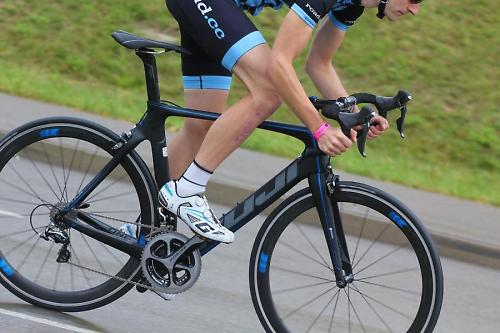
As much as you can gather from a short ride, the Transonic really impressed. It felt fast, that much was abundantly clear, but the steering and handling was one of a very stable and surefooted bike with none of the drama of some other bikes in this sector. More time is certainly needed on familiar roads to fully asses the new Transonic, but it does appear Fuji have created a very usable and engaging aero road bike that should be well suited to performance cyclists wanting a fast bike for all riding as much as it's clearly suited to racing.
We can't wait to get a test bike in for a longer ride on familiar roads to see how it really stacks up. You can see the full Transonic range at www.evanscycles.com
David worked on the road.cc tech team from 2012-2020. Previously he was editor of Bikemagic.com and before that staff writer at RCUK. He's a seasoned cyclist of all disciplines, from road to mountain biking, touring to cyclo-cross, he only wishes he had time to ride them all. He's mildly competitive, though he'll never admit it, and is a frequent road racer but is too lazy to do really well. He currently resides in the Cotswolds, and you can now find him over on his own YouTube channel David Arthur - Just Ride Bikes.
Latest Comments
- HarrogateSpa 3 sec ago
I quite liked the Cycling song/video, but I couldn't understand what was said at the end....
- Rendel Harris 5 min 16 sec ago
You seem to be making an assumption that the guilty party was an illegal immigrant and/or was working illegally, I can't see anything in the...
- andystow 23 min 43 sec ago
I'm 53, and gained most of my cycling fitness after age 43. I've never done an FTP test nor used a power meter, but based on occasionally asking...
- ubercurmudgeon 24 min 55 sec ago
I doubt you'll need to worry about facing that particular dilemma: by the time you find yourself in need of a pump, it'll probably have fallen off...
- mdavidford 42 min 18 sec ago
Except that presumed liability is usually a matter of civil liability, so you wouldn't be prosecuted as a result of it (though you may be held...
- brooksby 1 hour 10 min ago
Didn't know that, thanks. I wonder whether he also pushed for regulation of sex work…
- brooksby 1 hour 13 min ago
I always find it surprising how little often needs to be changed, to have the bike feel more comfortable. Often literally a case of lifting...
- Rendel Harris 1 hour 31 min ago
Well, I finally got some response from my repeated requests as to what was happening with the alleged database and was supplied with a link which...
- brooksby 3 hours 1 min ago
Thanks - was about to say that.
- Miller 4 hours 14 min ago
Don't buy American.


















Add new comment
2 comments
hmmm aero and a beefy spacer under the stem? controversial.
I'm guessing because its black....it must be really fast lol